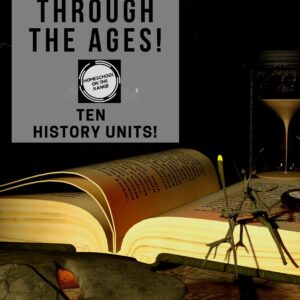Although the people we study in history lived decades or even centuries ago, their actions impacted how we live our lives today. Names, dates, facts…these are some of the things that I hear students complain about when they talk about disliking history. It’s too confusing…they can’t put it into context. A visual display, however, can help tie everything together in an easier-to-digest format! Our two favorite, visually-appealing ways to link historic events include this book (fantastic for those with small spaces) and this wall chart (for those with a dedicated homeschool area).
But it’s not just faceless names and random dates; history is full of transitional events that have altered the world’s story. By learning about different eras, you start to see what changes might happen in the future and what would drive that change. For example, learning about the fall of Rome teaches you that even the most powerful society can fall apart—and what happens to cause that crumbling.
By studying history, humanity has a chance to learn from its mistakes, theorize about alternative options based on correcting past mistakes as it moves forward with future events. After all, history rhymes…so it’s likely that there will be a chance to act differently in the future.
There are five concepts – or 5 Cs – of history. These are at the heart of every question historians ask as they seek to better understand the past, and they include (from most easily understood to the more complex): change over time, causality, context, complexity, and contingency. The strangeness of the past enables us to step back and look at our society and ourselves from a new perspective—indeed, we might start to look a bit strange to ourselves! (Think not? Check out Motel of the Mysteries)
There are five concepts – or 5 Cs – of history. These are at the heart of every question historians ask as they seek to better understand the past, and they include (from most easily understood to the more complex): change over time, causality, context, complexity, and contingency. The strangeness of the past enables us to step back and look at our society and ourselves from a new perspective—indeed, we might start to look a bit strange to ourselves! (Think not? Check out Motel of the Mysteries)
General Ancient History
Classes
- Sparks Academy Co-Op World History (or self-paced version)
- Ancient World History course
- History of Ancient Civilizations course
- Understanding Ancient History course
Printables
- World History Literature Bundle
- World History II Literature Bundle
- A World of Adventure
- Write Bonnie Rose
- Writing Through History
- Using Primary Source Documents
Extras
- Mysteries in Time adventures
- Bricks / Legos Through the Ages
- Ancient Artistic Pursuits
- History of the Ancient World
- Tales of Ancient Worlds
- Drive Thru History – Ancient History & DTH Adventures
- Ancient Cities (dvd)
- Audiobooks for World History
Egypt
Greece
Rome
- Eagle of the Ninth book club
- Ancient Rome online unit
- SPQR: History of Ancient Rome
- Famous Men of Rome
- Caesar’s Legions
Asia / Middle East
Medieval
- Sir Gawain & the Green Knight book club
- Legendary Swords morning plans
- Renaissance unit
- Renaissance Time Travelers
Mythology
Rabbit Trails
- Daily Life in the Ancient World
- Greek Fire, Poison Arrows, and Scorpion Bombs: Unconventional Warfare in the Ancient World
- Independent Research
- Archaeology
- Mansa Musa
- Ancient Mayans
- Vikings
- Wulf the Saxon
.jpg)


